Table of content
Crispy pork belly, with its golden, crackling skin and tender, juicy meat, has become a global culinary sensation. From Michelin-starred restaurants to humble home kitchens, this dish captivates taste buds with its contrasting textures and rich flavor. Yet, achieving the ideal balance between a shatteringly crisp exterior and perfectly cooked interior requires precision, patience, and an understanding of the science behind roasting. One of the most frequently asked questions by home cooks and aspiring chefs alike is: How long does it take to roast crispy pork belly to perfection? This article delves into the intricacies of pork belly roasting, exploring variables that influence cooking time, step-by-step techniques, and expert tips to ensure your dish emerges from the oven as a triumph of flavor and texture.
The Science Behind Crispy Pork Belly
Before diving into cooking times, it’s essential to grasp the biological and chemical processes that transform raw pork belly into a culinary masterpiece. Pork belly, a fatty cut from the underside of the pig, consists of layers of muscle, fat, and connective tissue. The key to crispy skin lies in the dermis—a tough layer of collagen-rich tissue just beneath the surface. When heated, collagen breaks down into gelatin, while the skin’s moisture evaporates, leaving behind a brittle, golden crust. Simultaneously, the fat renders, basting the meat and keeping it moist during cooking. Achieving this delicate equilibrium demands careful temperature control and timing.
Factors Influencing Roasting Time
Cooking crispy pork belly is not a one-size-fits-all process. Several variables affect the total roasting time, including:
- Oven Type and Calibration: Gas ovens, electric ovens, and convection ovens distribute heat differently. Convection ovens, with their fan-assisted circulation, often reduce cooking time by 10–20% compared to conventional ovens.
- Pork Belly Thickness: Thicker cuts (2–3 inches) require longer roasting times to ensure the meat cooks through without burning the skin. Thinner slices (1–1.5 inches) cook faster but demand vigilance to prevent over-drying.
- Desired Crispiness: A deeply caramelized, ultra-crispy skin may necessitate an additional 15–30 minutes under high heat, while a moderately crisp texture can be achieved with shorter final broiling.
- Starting Temperature: Roasting pork belly straight from the refrigerator versus allowing it to reach room temperature (60–70°F/15–21°C) impacts cooking time. Cold meat takes longer to cook.
- Basting and Seasoning Techniques: Methods like scoring the skin, salting, or using baking soda to dry the surface can accelerate crisping but may slightly alter total time.
Step-by-Step Guide to Roasting Crispy Pork Belly
Preparation: The Foundation of Crispiness
Scoring the Skin: Using a sharp knife or razor, score the skin in a crosshatch pattern, cutting through the dermis but not into the meat. This allows fat to render and steam to escape, preventing sogginess.
Drying the Skin: Pat the pork belly dry with paper towels. For ultra-crisp results, refrigerate it uncovered overnight on a wire rack. This dehydrates the skin, a technique borrowed from traditional Chinese siu yuk preparation.
Seasoning: Rub the meat (not the skin) with a mixture of salt, pepper, and aromatics like garlic, rosemary, or five-spice powder. Avoid oiling the skin, as excess fat can hinder crisping.
Initial Roasting: Rendering Fat and Cooking Meat
Low and Slow: Preheat your oven to 250°F (120°C). Place the pork belly on a wire rack set over a baking tray to elevate it, ensuring even heat circulation. Roast for 2.5–3.5 hours. This gentle heat melts the fat and gently cooks the meat, preventing it from seizing up.
Temperature Check: After 2 hours, insert a meat thermometer into the thickest part of the meat (avoiding contact with bone or fat). The internal temperature should reach 145°F (63°C) for medium-rare or 160°F (71°C) for well-done.
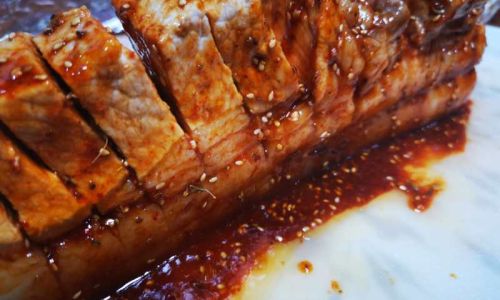
Crisping the Skin: The Final Showdown
High Heat Finish: Increase the oven temperature to 475°F (245°C) or activate the broiler. Roast for an additional 15–30 minutes, monitoring closely to prevent burning. The skin will puff and blister, turning golden-brown.
Alternative Methods: For convection ovens, reduce the high-heat phase to 10–20 minutes. Air fryers can achieve crispy skin in 8–12 minutes at 400°F (200°C), but require cutting the pork belly into smaller pieces.
Resting and Serving
Resting Period: Allow the pork belly to rest for 10–15 minutes before slicing. This redistributes juices and firms up the meat, making it easier to carve.
Serving Suggestions: Pair with pickled vegetables, apple sauce, or a tangy chilli-garlic dip. Crispy pork belly shines in tacos, ramen bowls, or as a standalone centerpiece.
Cooking Time Variations by Method
| Method | Total Time | Key Tips |
|---|---|---|
| Oven Roasting | 5–4.5 hours | Low-temperature start; monitor skin during high-heat phase. |
| Air Fryer | 1–1.5 hours | Cut into 2-inch cubes; flip halfway for even crisping. |
| Sous-Vide + Roast | 6–8 hours (sous-vide) + 30–40 mins (roast) | Precision cooking; finish under broiler for skin. |
| Grill/BBQ | 2–3 hours | Indirect heat; use a smoker box for added flavor. |
Troubleshooting Common Issues
-
Soggy Skin:
- Cause: Insufficient drying or low roasting temperature.
- Fix: Pat skin dry with paper towels; increase final crisping time.
-
Uneven Cooking:
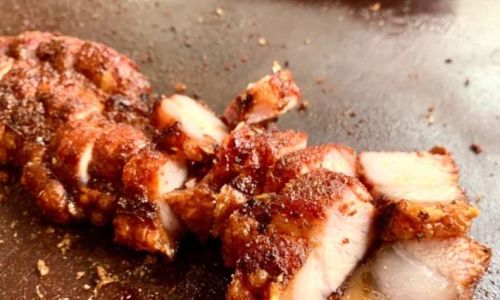
- Cause: Oven hot spots or uneven meat thickness.
- Fix: Rotate the tray halfway; use a meat thermometer to check multiple spots.
-
Burnt Edges:
- Cause: Oven temperature too high or skin too close to heating element.
- Fix: Tent edges with foil during high-heat phase; reduce broiler time.
-
Tough Meat:
- Cause: Overcooking or insufficient resting.
- Fix: Remove from oven at 145°F (63°C); rest for 15 minutes.
Advanced Techniques for Enthusiasts
-
Salting Technique:
Rub coarse salt into the scored skin 24 hours before cooking. The salt draws out moisture, intensifying crispiness. Rinse off the salt before roasting. -
Baking Soda Hack:
Dust the skin with a pinch of baking soda 1 hour before cooking. This raises the pH, accelerating Maillard browning.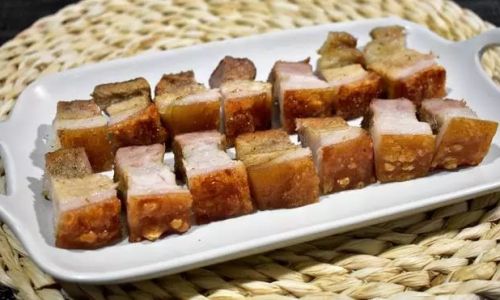
-
Deep-Frying (Chef’s Method):
For restaurant-quality crispiness, par-roast the pork belly, then deep-fry at 375°F (190°C) for 3–5 minutes.
Cultural Perspectives on Crispy Pork Belly
Crispy pork belly transcends borders, with each culture offering its own twist:
- Chinese Siu Yuk: Marinated in five-spice, honey, and soy sauce, then roasted until the skin shatters like glass.
- Italian Porchetta: Stuffed with herbs, garlic, and lemon zest, slow-roasted to melt-in-the-mouth perfection.
- Mexican Carnitas: Simmered in lard until tender, then crisped in a hot pan.
Despite these variations, the principle remains the same: patience and precision in roasting time.
The Verdict: How Long Should You Roast Pork Belly?
For a 2-pound (900g) pork belly with 1.5-inch thickness:
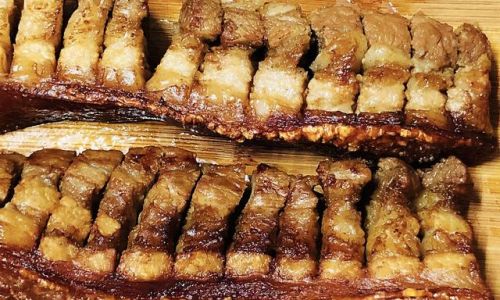
- Low-Temperature Roast: 3 hours at 250°F (120°C).
- High-Heat Crisp: 20 minutes at 475°F (245°C).
- Total Time: 3 hours 20 minutes.
Adjustments:
- Thicker Cuts: Add 30–45 minutes to the low-temperature phase.
- Thinner Cuts: Reduce low-temperature roasting by 30 minutes.
- Air Fryer: 1 hour total (including high-heat finish).
Conclusion: The Journey to Perfect Crispiness
Mastering the roasting time for crispy pork belly is an art that rewards experimentation. While guidelines provide a roadmap, trust your senses: listen for the sizzle of rendering fat, watch for the skin’s golden transformation, and rely on the meat thermometer’s truth. Whether you prefer the smoky allure of the grill or the precision of the sous-vide, the goal remains the same—a symphony of textures that honors this humble yet revered cut. So, fire up your oven, arm yourself with patience, and embark on a culinary adventure that promises crackling satisfaction with every bite.
Final Tip: Keep a log of your cooking times, temperatures, and results. Over time, you’ll develop an intuitive mastery of pork belly roasting, turning each attempt into a step closer to perfection. Bon appétit!
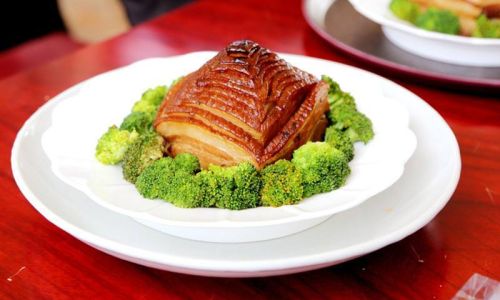
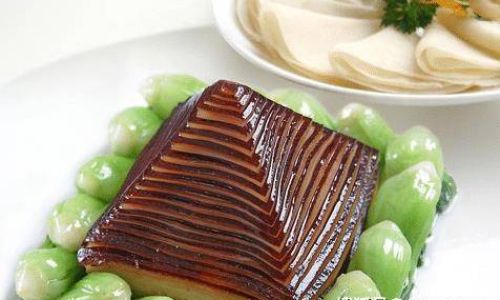

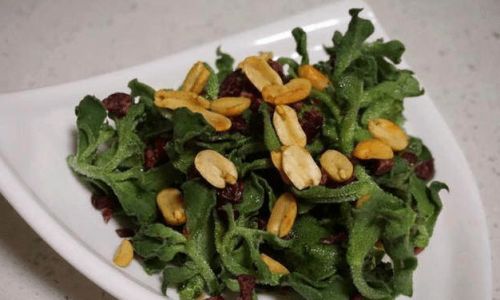
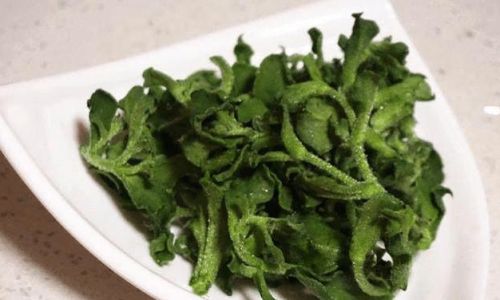
0 comments